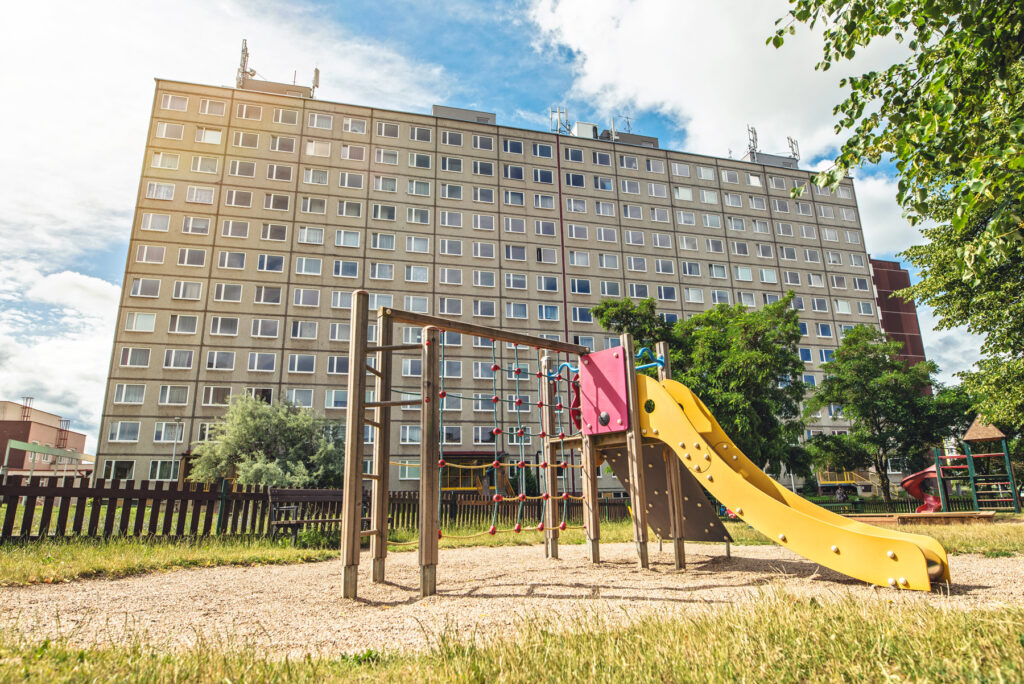You can also listen to this text:
[šis tekstas – anglų kalba; jo vertimas į lietuvių kalbą pasirodys netrukus]
The hairdresser’s story
This real estate development [sídliště] was very beautiful in the very beginning, when we moved there… Our son was little back then. I even have a feeling that the architect who planned this development received a prize for it. This is not the type of disgusting real estate where buildings are too close to each other, like they build them today. It was easily accessible from the metro and close to nature… There were so many children there, and a school. A nice place to live and nice people.
When they did not sell it to us for the first time in 2003, a big part of our friends left. But we were still hoping… If they had told us right away that they would never sell it to us, we would have also moved like our friends did. But they were holding us hostage. We did not know what would happen. We did not want to lose this flat. We knew that it was not ours, but you know… People do not want to invest in something which is not theirs, but we wanted to have a nice bathroom and things… We were hoping that we would own it some day.
I will tell you what was really terrible. We were crying, literally, when… Well, I cannot talk now, I remember that moment, and I want to cry again. So, they came to take our flat from us. That day we were there for the last time. They came to take the keys. I must say we had been crying a lot before that moment. Before they came, I told my husband: ‘We will not cry in front of them, ok? We’re not going to make them happy and see us destroyed. We will be strong, ok?’ And when they came, we burst into tears… It was terrible…
The hairdresser tells me this story while highlighting my hair in a small salon in Prague’s Žižkov district. I had been waiting for this interview for almost half a year—I thought that there was something particular about her story and there were reasons why she was so reluctant to speak.
We had first met at the “Rebel Prague” festival of urban resistance that my friends and I had organized a few years ago. During that hour at her salon, I understood my stupidity, combined with a sociologist’s arrogant need to convert a tragedy of displacement into a data set for an academic study.
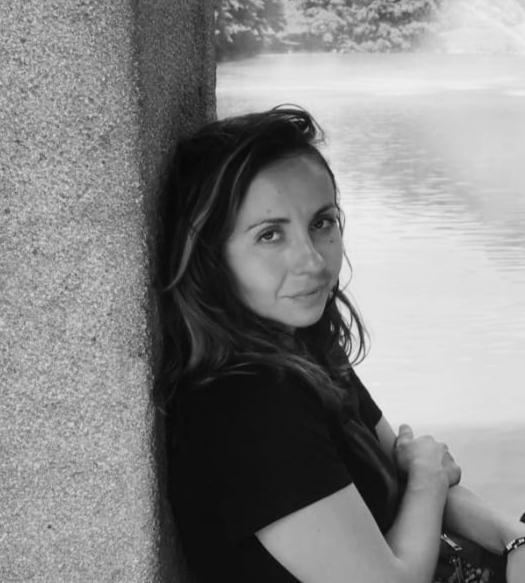
The reason for her reluctance was neither her involvement in power games nor an important position in organizing structures. It was her sorrow over the loss of housing, community, friends, and years of hope that had melted into air. All that made her cry, again, on the day of my visit. I felt how much she wanted to be strong in the face of unjust economic and political forces. But she could not—either back then or today.
A similar story happened to the tenants in 739 apartments of the Písnice real estate development that was privatized by a private investor, and not the sitting tenants.
The tenants, however, did not leave their flats, where they had spent 30 years, to the speculators without a fight. They organized an initiative, called “Moje Písnice” (“My Písnice”). This article tells their story.
Písnice real estate development: a nice place to live
Several blocks of flats, called Písnice, were built on the outskirts of Prague in the mid-1980s. When locals describe this place, they usually refer to it as a “nice place to live” (příjemné místo pro život). The nice place to live usually involves the nearby valley, peace and quiet, spaciousness (uncommon among present day developments), small hills, trees and bushes, and a community of friends and acquaintances.
There are approximately 700 apartments, a school, and a swimming pool where local kids used to learn to swim. There were barbecue spots to roast sausages on Christmas and the New Year, rooms where ping-pong tournaments were held, common laundry rooms, and the “communist rooms”, as the locals call them—rooms for collective meetings—as well as rooms to keep baby carriages. These rooms, including the pingpongárnas, were later turned into flats. Because rent brings more profit than communal spaces do.
In accordance with the socialist imagination of the time, housing was not individualized. It was rooted in other spheres of life which enabled creation of ties between tenants, which are missing from life in contemporary cities. They knew each other from workplaces: there were several different state-owned factories and enterprises around. For example, a meat factory that was later transformed into the most famous Vietnamese market in Prague, Sapa.
Jobs in state enterprises brought many young families to the area. To get the flat, one had to fulfill the requirement of working 500 hours on the construction site: the tenants built their houses with their own hands. Families that were working and living in the same space shared life: they were of the same age, with similar jobs, had children of the same age, were taking walks near the same valley, going to the same swimming pool. Pavel, one of the locals, describes this socio-historical coinciding:
People were moving to these flats just like all people were moving to flats of state enterprises at the time. They’d be around 25 or 30 years old, men after the army, women after an internship. If they had a kid, they could ask for a flat from a state enterprise, sign an agreement that they would work for this company for 10 years, and they would get a flat. We speak about the 1980s, about the totality – this was the way to get housing. Now they are in their 60s.
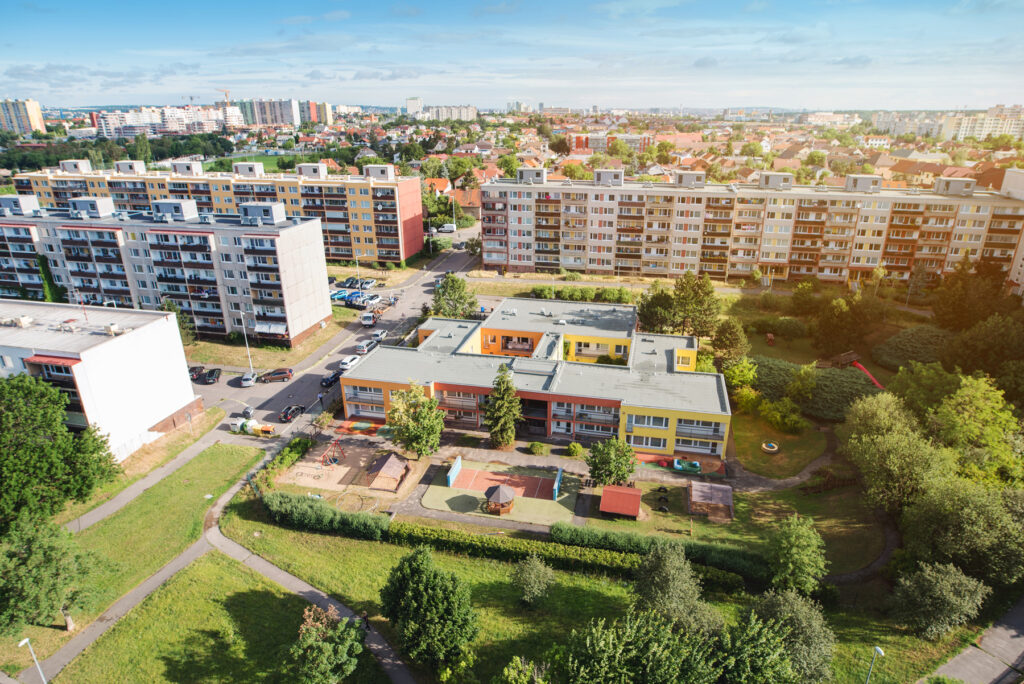
Shared life created not only a bonded community, but a coherent social group of contemporaries with similar aspirations in life. In the 1980s, they did not yet know that they would also share the drama of the transformation to a capitalist economy and irresponsible state, as well as the experience of unfair privatization and displacement.
The change came after the Velvet Revolution, when Písnice was transferred from state ownership to the Czech Energy Company (České Energetické Závody, ČEZ) that was responsible for privatization. ČEZ was the owner until 2016. It did not invest in repairs, but tenants had long-term agreements with a stable rent.
In 2016, instead of privatizing the flats to the sitting tenants, which was a common practice in post-socialist states, ČEZ sold it to a private investor, CIB, which still owns the development. This privatization led to a rapid rise of rents, termination of long-term contracts, and deterioration of the community (as many of the tenants moved out). Disinvestment brought general decay to the area. The currently planned development is so alien to the initial concept of the area that the architect who authored it filed a complaint against the new development to protect his intellectual property rights.
Iniciativa Moje Písnice: what a mortal can do in the face of capitalism
It was a shock for me. Look, I was so naïve… I found the letter in my postbox, and it was written there that they will sell the real estate development. I said, thank God, finally. I took that letter, in my leggings, jumped on my bike, and went to the local mayor. But he did not know about it either, he was also shocked.
– a woman in her 60s, a protagonist of the Iniciativa Moje Písnice, tells her first impressions from the day when she knew that all the houses would be sold. However, they would be sold in a tender that would make the participation of the tenants impossible. Then, the locals started to organize Iniciativa Moje Písnice, which became one of the most tragic battles for fair privatization in Prague.
Iniciativa decided to lead two different fights, legal and political. In their legal fight, they were arguing that the initial transfer of state property to ČEZ was not legitimate, but this fight was lost when they had to withdraw their appeal in 2020, facing the risk of paying fees to ČEZ that would amount to economic suicide, as well as the court procedure costs.
The political fight was based on pressuring the politicians to change the conditions of the tender. Their tactics were organizing protests and demonstrations, picketing, writing letters, creating media coverage, meeting politicians (including ministers and even the Prime Minister) and ČEZ employees. An alternative strategy was based on the possibility of the district municipality buying out the real estate development and then either renting it to the tenants or enabling privatization. The active core of Iniciativa met repression: the CIB filed a lawsuit for the reputation damage and attempted to terminate the rent agreements. This political fight continued from 2016 to 2019, when it became obvious that it cannot be won.
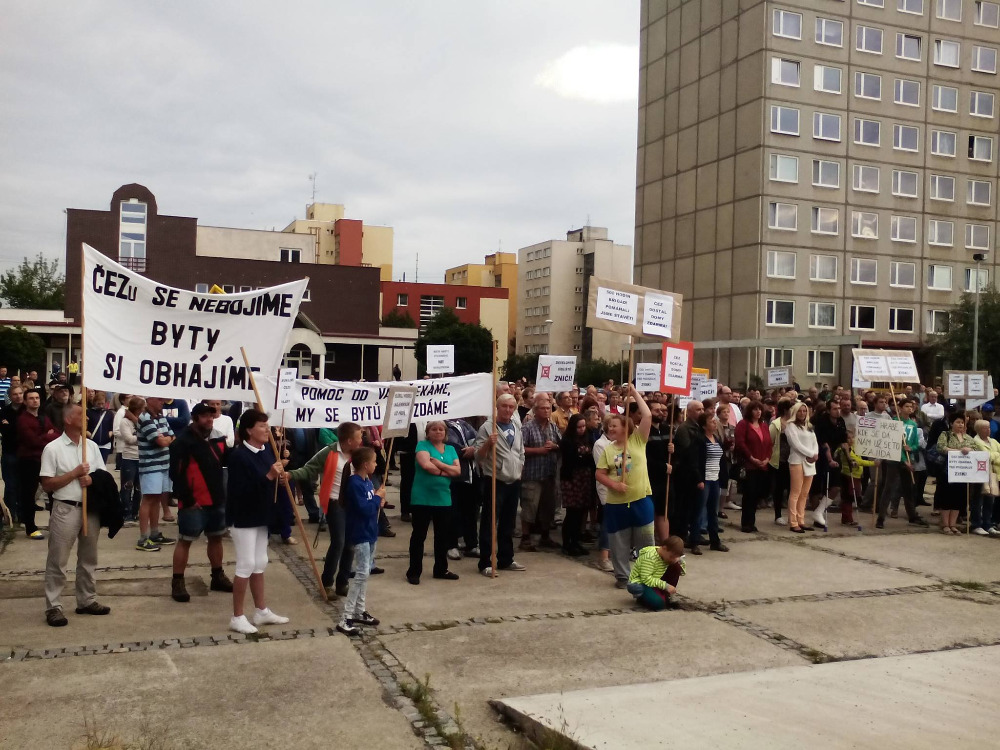
Iniciativa lost more than just a political fight. Local people lost their homes, friends, and communities. However, there are several lessons to be learned from this, regarding both the socialist past and the post-socialist capitalist present. The first lesson is the ambiguity of the privatization process and consequences of particular types of privatization (by a big investor or developer that essentially cannot guarantee good housing conditions and often cause popular discontent) in comparison to others (by sitting tenants).
Another lesson refers to a tactic (“asking the power for help”) in the context of a contemporary state, the very political autonomy of which is questionable. Members of Iniciativa often point out in their reflections that they should have been more confrontational. In a heavily mediatized public space, being confrontational and challenging the politicians’ legitimacy by direct actions may be a better tactic than hoping that rather small demonstrations in front of the parliament would be heard. The last lesson regards the loss of community, which is connected to the loss of particular types of architecture and urban imagination.
Like the article? Press a button
Privatization as both security and trap
Privatization is criticized by many as a neoliberal practice that leads to the reign of private interests in the city, as opposed to the public ones. This process underlies the transformation of housing estates into gated communities, enclosure of public spaces, transformation of urban commons (water, public transport, etc.) into profit-making commodities, and so on. And while there is definitely some truth in these arguments, privatizing flats in the post-socialist context is a completely different process.
Owning one’s housing is a very strong tendency in the Czech Republic (only 20% of inhabitants rent theirs). Considering the fact that tenants have almost no rights (chaining one-year short-term agreements enable unregulated rent increases but do not guarantee prolongation), one might conclude that only ownership can guarantee a stable and secure living. This is why, when the people from Iniciativa describe their fight, they do not say that their goal was “to privatize the flats”, they generally say “we wanted to dwell [chtěli jsme bydlet]”, by which they meant “to own one’s place of living”. In this imagination, living is not separable from owning one’s home. And while this might be seen as some type of “petit-bourgeois demand”, in the case of Písnice one does not speak about a privatization that leads to a future possibility of profit, but about acquiring personal property that fulfills its initial function—housing.
The feeling of security provided by home ownership in times of economic, social, and political turbulence is related to political stances of city dwellers. As a housing working group of the Re-Set Platform, we carried out a militant research, which includes interviews with about 100 inhabitants, in this area. This type of research serves the needs of the movement and identifies local issues to work on.
During our research, we learned that people who own their flats tend to be much less nationalistic than those who live in rented apartments. There are many Ukrainian migrants coming to Písnice. Hate towards migrants and xenophobia are the most widespread among those who transfer their feeling of insecurity and fear of future onto those who are weaker and silent. The lesson is: housing security leads to a more tolerant society. And by “housing security”, one might mean stable long-term renting, regulated rent, landlords’ investments in reparations, and other mechanisms that decommodify housing (which means that the owner cannot be a capitalist entity), personal ownership, collective ownership, housing as commons, etc.
This argument allows one to understand why urban activism in Prague is as it is. Prague is a very dynamic city in terms of urban initiatives. A majority of them are composed of middle-class property-owners that seek to protect their homes from developers, who strive to overbuild any empty corner. Communities behind these initiatives are based on personal bonds, which are deemed worthy of building only when the place of living is considered stable. This is not the case of rented flats, where tenants do not have any legal protection.

The city government is toothless against developers: the manual for the investors’ financial contributions (into infrastructure and affordable housing) was published only recently, and it comes as no surprise that many local politicians went into politics to open doors to developers and investors. The city is reigned by private capital, and the groups fighting against it are exactly the individual real estate owners. Therefore, individual ownership (in many cases acquired through privatization) appears to be a force that preserves the urban space, not destroys it. Such a socio-economic composition of activists also explains the role of the middle class in urban activism in post-socialist Prague.
However, there is always a “but”. Real estate in Prague is already too expensive for those who do not have financial support from their families. While income differences might not seem that big (if we do not consider the extreme profits of oligarchs and CEOs), the major injustice and class division is based on differences in ownership. The solution to this is a diversification of possible types of housing (baugruppe, cooperatives, state and municipal housing, etc.). Here, privatization shows its ugly face: who would go for alternative types of housing in a society where security is guaranteed only by privately owned flats? Iniciativa Moje Písnice also fell into the trap of limited urban imagination: only one type of fight (for fair privatization) was seen as worthy, while others (e. g., struggle for tenants’ rights) were not even considered.
“Crying for help” as tactics towards unresponsiveness of power
Me: And so, whom do you consider to be your biggest enemy?
The Hairdresser: Who was the enemy? Who is responsible for our destiny? First of all, it’s money. And, of course, politicians. But first and foremost, money…
This part of the interview unveils the perception of the enemy: it is the entwinement of financial and political interests into an unbreakable, unresponsive, and arrogant structure that has nothing to do either with democracy or with actual interests of any people whatsoever.
Members of Moje Písnice were active in protesting, lobbying, meeting, breaking into dinners and official events of the politicians, picketing in front of the parliament and seeking support inside it. Exploring the timeline of this initiative makes any radical activist proud and slightly jealous. But the response from all politicians on the state level was the same: none. Except for two politicians, Iniciativa did not manage to gain support in the parliament, despite the fact that the state has a majority share in ČEZ. Whatever they did, the Leviathan did not turn its eyes towards them.
The common explanation of such behavior of state politicians implies that post-socialist states are not politically autonomous entities, but clews of informal connections from which the threads spin into economy, healthcare, education, and other institutions. Naturally, in such conditions, one could not expect that politicians will act as politicians, i. e., stand the ground of people and protect their interests. At first, members of Iniciativa believed this, but then they realized that they had been naive and they were alone in their fight. This bitter realization brought a loss of trust in democratic institutions and re-evaluation of their tactics.
The common mistake that was mentioned by members of Iniciativa was a lack of radicality. It does indeed feel strange to hear a 60-year old person saying that what they had to do was occupations and blockades instead of protests. The strangeness of this re-evaluation, however, is hope and empowerment at the same time. An active member of Iniciativa, now an owner of a small sports-equipment shop, said:
Now I would say that we had to be more aggressive. I would do a blockade of something. The blockade of the government. I think we were trying to find the solution, asking for help. All the time it was something like a demonstration in front of the government, it was a cry for help. We did not confront them publicly. We were saying: you don’t care about us! You do not do what you are supposed to do as our representatives! You support the oligarchs but not us! This was a mistake.
What underlies this critique of moderate tactics is an initial belief in the state and representative democracy. Members of Iniciativa were “crying for help” because they believed that the state must take care of the issue and must respond to their grievances. But it did not. This, in turn, led to radicalization of tactical thinking of the people who are currently in their 60s.
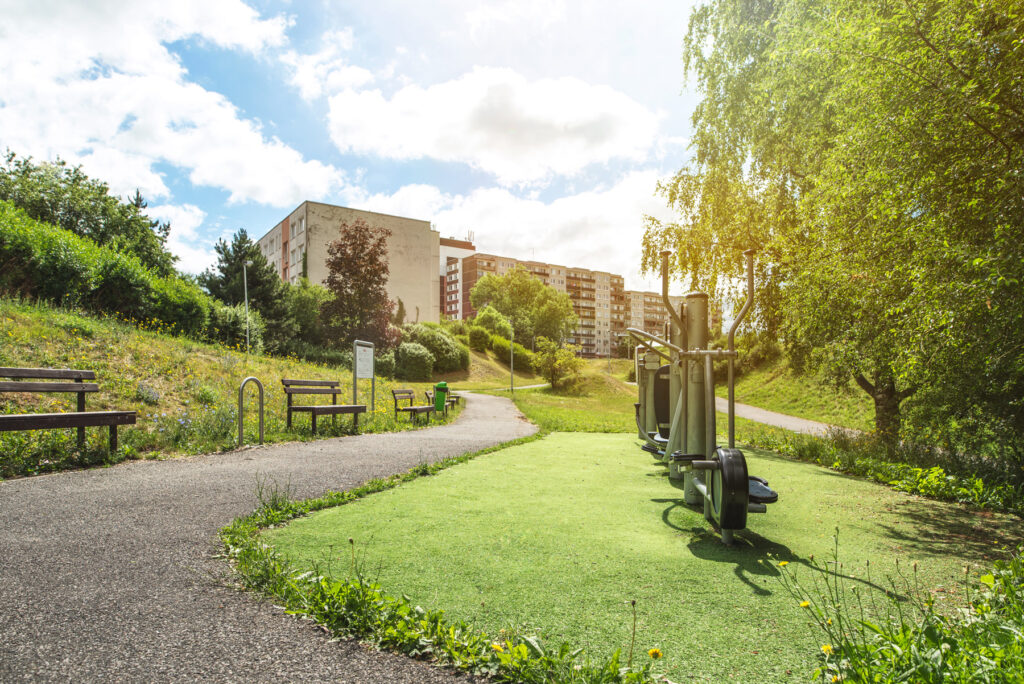
The lesson learned? Intertwinement of moderate and radical types of tactics in political work is essential. In the case of Písnice, it did not take place because the radical branch of the urban grassroots learned about the initiative a little too late. What would have changed this situation was proper organized militant research and networking from both sides on a systematic basis. And if you do radical political work and think that pensioners and small property owners are not radical enough, then the Písnice case serves to demonstrate the opposite: they might be not just radical, but also desperate, which is an explosive combination. As Lenin observed in What Is to Be Done?: “The only ones who fear temporary alliances, even with unreliable people, are those with no confidence in themselves’, that is, in their own strength.”
Loss of community in post-socialist capitalist urban environment
Finally, one of the consequences of the tenants’ dispossession was the loss of community. The impossibility of owning the property, which could bring the basic security in an unstable post-socialist context, made many tenants move from the area. Maria, one of the tenants, now in her 50s, shares her feelings from the collective resistance and its aftermath:
I think that, because of this situation, we became closer. Because we had to deal with such essential things together. This is why it is even worse… This is why we regret even more that we left. That this community was torn apart. I don’t know, I think that half of the people left, maybe more. Everything went wrong there.
Individual feelings and histories, however, are always feelings and histories of the societies in which they appear. A functioning community in Písnice was not given only by the experience of a capitalist drama, but by the previous experience of shared life. The transition from socialist past to post-socialist capitalist present is a transition of forms of social relations, subjectivities, and architecture that reflects and defines them.
To emphasize this point, let me make a small excursus into the Czech vanguard thought of the 20th century. The famous Czech art historian Karel Teige spoke about “collective houses”, with “minimal flats”, used only for “sleeping, resting, and individual spiritual and emotional life”, separated from all other shared cultural and social facilities (canteens, sport halls, schools, people’s kitchens, clubs, workshops, etc.) Teige thought that this type of architecture is more suitable for the liberated working class than the apartments which were created for bourgeois families possessing capital and property. “When there is no property, there is no reason for the bourgeois family and household (with a subordinate position of women) to exist”, Teige concludes.
This far-reaching imagination did not fully materialize in socialist architecture (no wonder, Teige was also a surrealist). However, some of Teige’s thoughts were definitely correct: architecture and society mutually influence each other. Teige’s and others’ (for example, famous French architect Corbusier, who is responsible for the entire concept of a communist block of flats) vanguard thought was based on the idea that de-individualized housing creates commonality and bonds between people, on which socialism is based. Furthermore, urban vanguard thought articulated the interconnectedness of the housing question with the economic and political regime (one must change the latter in order to change the former).
Písnice is a good example of both statements. However, the architecture alone does not create a particular type of social relationship but serves as an infrastructure for other interconnected spheres of life, through which commonality appears: common work in the factories, common spaces for leisure, swimming pools where children of the same age go, common housing. All this enables us to share sequences of acts in the life drama and bring a community and deindividualized type of subjectivity about. Today, the area is populated with people of different ages, seasonal construction workers from Ukraine, Vietnamese migrants, tenants with short-term agreements who have no attachment to the place, and a tiny group of old-timey residents. It is a space with a high fluctuation of tenants (caused, among other things, by displacement), freedom of movement defined by the capitalist forces, and no community.
In an individualized capitalist society, not only creative-critical thinking about urban space as essential for commonality disappeared, but also the conjunction of the shared spheres of life: accommodation, work, and leisure. When the local people from Písnice remember the socialist times, they sometimes say that the people were different. They were more open, easier to communicate to, life in general was more cooperative and collaborative. With the rise of the capitalist order, this life is lost, as well as its architectural base. Ivan, husband of the hairdresser from Žižkov, describes this decline from the beginning through the Velvet Revolution and final privatization:
We are people in that block… We had known each other for thirty years, you know. The revolution split us apart, everybody started to take care of themselves only… But we were still that one block, we still knew each other. Now I don’t even have an idea who lives there.
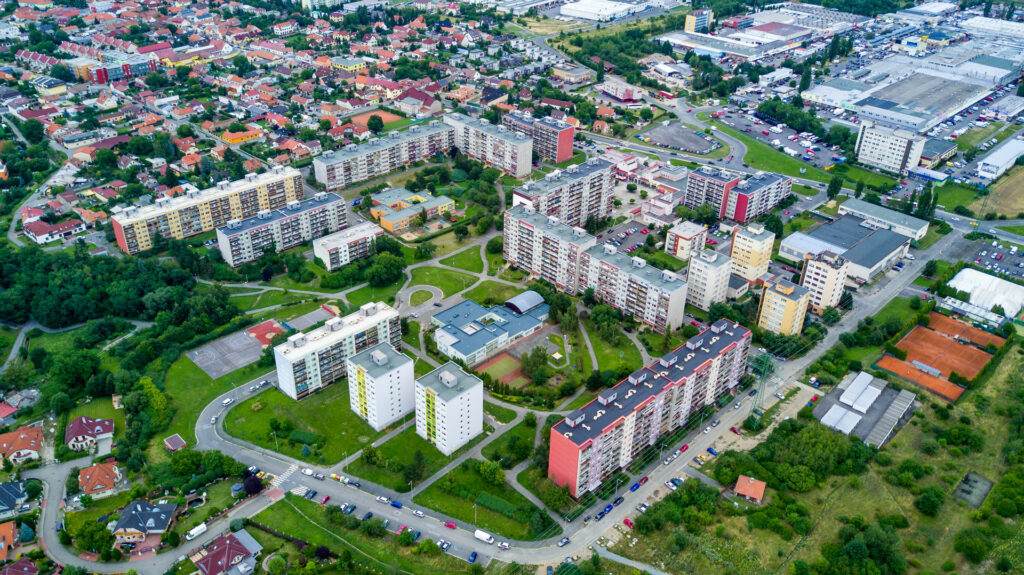
Yuliya Moskvina is a sociologist, housing and right to the city activist, and correspondent to GPB in Prague.
Taip pat skaitykite
-
The Interview: How to Occupy a University? The pro-Palestine Student Occupation of Ljubljana University
-
“In Slovakia the whole process is the same as in Hungary and Poland, but like on steroids, it’s much faster”. Interview with Tomáš Hučko
-
„ChatGPB and a half“: Qassem from Gaza – „You don’t destroy political thought by weapons”
-
Challenges of healthcare reform in Ukraine: on workers’ perspectives and struggles
-
Ian Parker: The Psy Professions, Pathology and Alternatives

